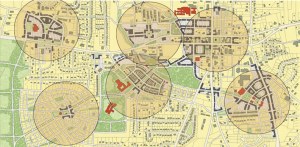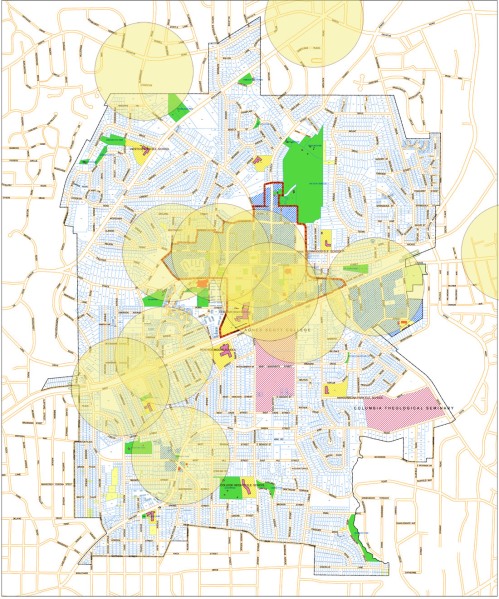 Having worked in communities big and small across the continent, we’ve had ample opportunity to test ideas and find approaches that work best. Urban design details. Outreach tactics. Implementation tricks. Many of these lessons are transferable, which is why we’ve created “Back of the Envelope,” a weekly feature where we jot ’em down for your consideration.
Having worked in communities big and small across the continent, we’ve had ample opportunity to test ideas and find approaches that work best. Urban design details. Outreach tactics. Implementation tricks. Many of these lessons are transferable, which is why we’ve created “Back of the Envelope,” a weekly feature where we jot ’em down for your consideration.
Most folks with an interest in planning issues are no doubt familiar with the pedestrian shed or ped shed. The idea is simple. Experience has shown us that the average person will walk, without hesitation or undue kvetching, to destinations they can reach in under five minutes — in practical terms, about a quarter mile — beyond which they begin to consider other modes of travel.

Image credit: DPZ, “Sprawl Repair Manual.”
(It’s worth noting that the five minute walk is a pretty rough tool and there are plenty of exceptions. Planner Peter Calthorpe suggests a half mile/ten minute standard when assessing proximity to transit and, in walkable communities, children will often walk even further for school. Furthermore, people rarely walk a straight line to their destinations, taking more circuitous, on-the-ground routes instead that add a little extra distance. But you get the idea.)
I find ped sheds especially interesting as they relate to economic development and the social fabric of community. That is, if people are out and walking then where are they ending up and who are they crossing paths with along the way?
My town of Decatur, Georgia — already pretty walkable, especially by Sun Belt standards — has, for the past 15 years or so, been developing a thriving pub scene. In addition to some long-time institutions already in place, we now have a growing number of neighborhood-friendly taverns spread around town.
These are where neighbors go, hang out, and get to know each other, and they’ve contributed to the fact that, here in Decatur, craft beer has pretty much become a de facto component of the city’s economic development strategy. So that got me thinking. Based on our existing establishments, what portion of our residents have a neighborhood pub in the truest sense of the term?
The result? The pub shed — a diagrammatic look at walkability and beer.
See it below (and click for a better view). Every circle is centered on one of our pubs and the results show homes within a quarter mile of each. Not too bad, especially for a small, southern town, but if it turns out that people are willing, like with transit, to walk ten minutes for suds rather than just five then, well, coverage improves dramatically.
The fun part (at least for geeks like me) is that you can do an exercise like this for any of your community’s shared amenities — coffee shops, schools, parks, etc. I just find pubs especially relevant because, if ever there was a business you should be walking to (and from) rather than driving, it’s your bar.
Thankfully, my particular residence is well served. Cheers!
–Scott Doyon
If PlaceShakers is our soapbox, our Facebook page is where we step down, grab a drink and enjoy a little conversation. Looking for a heads-up on the latest community-building news and perspective from around the web? Click through and “Like” us and we’ll keep you in the loop.












Pingback: Is Your ‘Neighborhood Pub’ Really in Your Neighborhood? | APA News Feed
The interesting aspect of pubs on the British Isles is that automobile parking is intentionally restricted.
That sensible policy seems like it could be a popular way to promote walkability, including parking restrictions, more generally.
Pingback: From Pedshed to PubShed – your 5 minute stumbling distance to good beer « Decisions, Decisions, Decisions
My pubmfriends have a rule depending on the level of intoxication, and we map each others routes home:
A-street, still respectable.
B-street, tipsy.
Alley, crawling.
Reblogged this on Stupidityflowering and commented:
This is the idea! Real, smart and fun development.
Pingback: How close is your local? « Convivial Urbanista
My nearest pub is about 1.5 miles by sidewalk. The best pubs near me are 7/10ths of a mile walk, a bus ride, and another mile to the Decatur map in the article above.
I just mapped it out for Grant Park, where I live, versus Poncey-Highland, where a friend lives. Our house sucks. Nothing within a 1/2-mile let alone 1/4 mile.
Great idea! I came across walk score couple of years ago – it measures the walkability of neighbourhoods http://www.walkscore.com/.
Is there an easy to access software that enables you to create ped sheds on a map? Scott and Mark, what software did you use to create your maps?
I love this idea! I want to do something similar for St. Louis. I second the question from Sivarajah…”Is there an easy to access software that enables you to create ped sheds on a map? Scott and Mark, what software did you use to create your maps?”
I won’t stake claim to doing anything the “proper” or “accepted” way, as planning-related graphics are outside my scope here at PlaceMakers, so take what I say with a grain of salt. Basically, I did it in Photoshop using a map provided by my city. All you have to do build a circle whereby its radius equals a quarter mile on the map’s distance key, fill it with color and make it partially transparent. Then just duplicate and drag them around to whatever destinations you’re looking to assess.
Good luck.
Pingback: When the Pub shed is a food desert | History Sidebar
Pingback: Urban Walking – Refilling the Well | Poetic Mapping: Walking into Art
Pingback: Get your Multi-Family into a Walkable Town Center! | PlaceShakers and NewsMakers